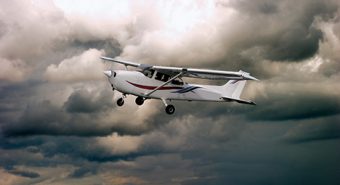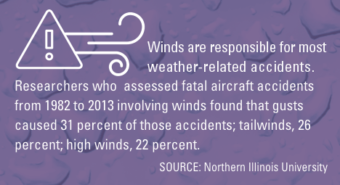
Oct. 30, 2017
Single pilots can minimize weather hazards in several ways, including through use of refresher training, flight service and weather data, mobile app graphics, PIREPs and more.

Weather is a contributing factor in 35 percent of general aviation accidents, and 75 percent of those mishaps involve fatalities, according to both the FAA and NTSB. So, it is clear that aviators – especially single pilots of business aircraft – should take steps to mitigate the risks of having an unfortunate encounter with nasty weather.
“You have to look at aircraft capability and your skill, especially for lower-performance aircraft,” before heading into the weather, said Mike Graham, director of flight operations, safety, security and standardization at Textron Aviation. “You look at the accident data, and [it’s clear that] items are being overlooked. There’s a lack of recurrent training, higher risk tolerance or a disregard for precautions.”
Single pilots are flying technically advanced props and jets, everything from Cirrus SR20s to Embraer Phenom 300s. That’s a wide range of aircraft with vastly different performance capabilities. Because of their investment, some owners are determined to get the most out of their aircraft, even when conditions are borderline.
During annual Part 135.293 reviews, there’s a significant emphasis placed on meteorology – recognizing severe weather, turbulence, icing and thunderstorms. While continued training and testing isn’t required under Part 91, Section 103 of that regulation requires that pilots “become familiar with all available and relevant flight information” and to “ensure meteorological conditions permit safe operations for the specified flight.” It also requires pilots to have a contingency plan for the flight. Graham suggests that aviators should ask themselves, “If the weather changes, what’s my out?”
Thorough Flight Planning, Refresher Training
Mitigating weather hazards begins with thorough flight planning.
“There are many tools out there,” Graham said. “With all the weather apps available, there’s no reason not to do good preflight planning.”
For many trips, Graham recommends planning a week ahead. By reviewing daily forecasts, pilots can spot trends, which may lead them to conclude that the weather risks involved with flying a particular mission can be mitigated by simply leaving a day earlier or later.
Nevertheless, risk assessment must continue all the way up to departure time and throughout the flight because weather can quickly change.
“Good judgment is needed,” said Graham. “Sometimes you just need to say we’re not going today.”
Other experts believe that refresher training is key to mitigating seasonal weather hazards.
Refresher training for a given season – an icing course in the fall, or a convective weather course in the spring, for instance – will help pilots make informed weather decisions, said Andrew Battleson of the CAE Embraer Training Center.
Refresher training for a given season – an icing course in the fall, or a convective weather course in the spring, for instance – will help pilots make informed weather decisions.
SIMCOM’s Tom Goonen supports mandatory training for icing, especially for operators of turboprops, and pressurized singles and twins. The FAA’s Advisory Circular 91-74B comprehensively covers icing hazards and proper flight planning.
Also, adhering to personal minimums not only reduces weather risks, it is an advantage that single pilots have over professional pilots.
Personal minimums are “the great equalizer,” said Mark Twombly of the Embraer Operators Association. “The professional is expected to perform. They’re going to go in most cases,” while single pilots can more easily adjust plans and stick to their personal minimums.
Flight Service and Weather Data
Goonen suggests pilots consult with flight service station briefers because they often can provide insights not possible to obtain simply by reading published weather reports or using onboard avionics.
“Flight service stations are very underused,” said Goonen. “These guys are experts and can give you a much better outlook than your radar or NEXRAD. During a flight, just tell ATC you’re going off frequency for a minute.”
When using onboard equipment to assess weather, pilots should understand how automation processes weather data. While the GPS shows your position in real time, weather information can be up to 20 minutes old because the signal takes a longer route to reach the cockpit.
NEXRAD and the data link used by weather service providers causes the latency, explained Gary Pokodner, a program manager at the FAA’s Weather Technology in the Cockpit division (WTIC). NEXRAD and similar systems, he said, are not designed for weather navigation, only avoidance.
“NEXRAD will show pop-ups or convection behind moving fronts,” explained Pokodner. “That opening [in a storm front] you see on the screen may not be there” by the time you arrive at that location. That’s why it’s essential for pilots to know their equipment’s limitations.
The WTIC NextGen program is researching ways to reduce gaps in a pilot’s weather knowledge and cockpit technology. One study shows when a METAR changes from VFR to IMC, many navigation devices don’t notify the pilot very well.

There’s nothing that jumps out,” Pokodner said. Some solutions include having the METAR turn white with a black background or making the text brighter. Having the text sparkle, flash or change color are other possibilities. There are devices with good salience (easily noticed alerts), and pilots should do their research, he advised.
Technology Should Reduce Pilot Workload
FAA research also has found that reducing the pilot’s workload also helps mitigate weather risks. For instance, winds reported graphically are easier for pilots to comprehend and faster for them to visualize, compared to text. Graphics also can provide runway orientation at a glance by showing the arrival runway with crosswind and tailwind vectors.
“Some apps just show vectors without splitting them into crosswind and tailwind components,” Pokodner warned. “Don’t take one when you need to do the math. This [a weather encounter] is a heavy workload time.”
PIREPs offer a three-dimensional look at the atmosphere. Any piece of information that a meteorologist is able to plug into a forecasting model helps the next forecast be that much better.
The FAA also is starting to study how effective weather avoidance voice commands would work in the cockpit. Scrolling through electronic pages or pushing buttons only adds to heads-down time. A pilot should just be able to say, “Show me the closest icing,” Pokodner suggested.
Despite all the cockpit automation, the incidence of weather-related accidents involving general aviation pilots remain high. An FAA study on using mobile devices found that many designs are not compatible with the way pilots use them. Pushing tiny buttons or tapping windows on a glaring screen to plod through complex, multi-level menus to reach vital information isn’t efficient or safe. It adds to a pilot’s workload, resulting in more head-down time and distractions. Single pilots should be navigating the aircraft, not the device.
This study concluded that automation should be “synchronized with the pilot’s workflow… so only a glance at the mobile application screen” is needed to show information needed for that phase of flight.
Don’t Forget PIREPS
For the best source of actual weather conditions, PIREPs can’t be beat, since they’re accounts of actual conditions aloft. Check them against METARS and other weather information sources to gauge the accuracy of forecasts.
“PIREPs improve the weather information and safety for all aircraft operations to avoid encounters with hazardous weather and prevent accidents,” states the NTSB.
“PIREPs offer a three-dimensional look at the atmosphere,” added John Kosak, weather program manager for NBAA Air Traffic Services. “Any piece of information that a meteorologist is able to plug into a forecasting model helps the next forecast be that much better.”
Some pilots are reluctant to file a PIREP. They may have a heavy workload or feel the report won’t benefit them. But if they can file a PIREP, it will help dozens of other aviators.
Review NBAA’s weather resources

View This Article in the App
This article originally appeared in the November/December 2017 issue of Business Aviation Insider. Download the magazine app for iOS and Android tablets and smartphones.
Download the Mobile App
Business Aviation Insider Digital Edition
We’ve redesigned Business Aviation Insider to provide a more engaging reader experience, both in print and online. Our digital edition is optimized for tablet users and available only via the NBAA Business Aviation Insider mobile app.
Download the mobile app for your iPad or Android tablet now.
Print Subscriptions
All Member employees are eligible to receive their own printed copies of Business Aviation Insider free of charge. To subscribe, update your communications preferences.


 International Business Aviation Council Ltd.
International Business Aviation Council Ltd.